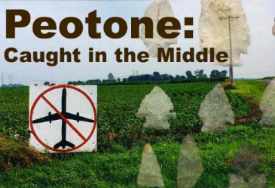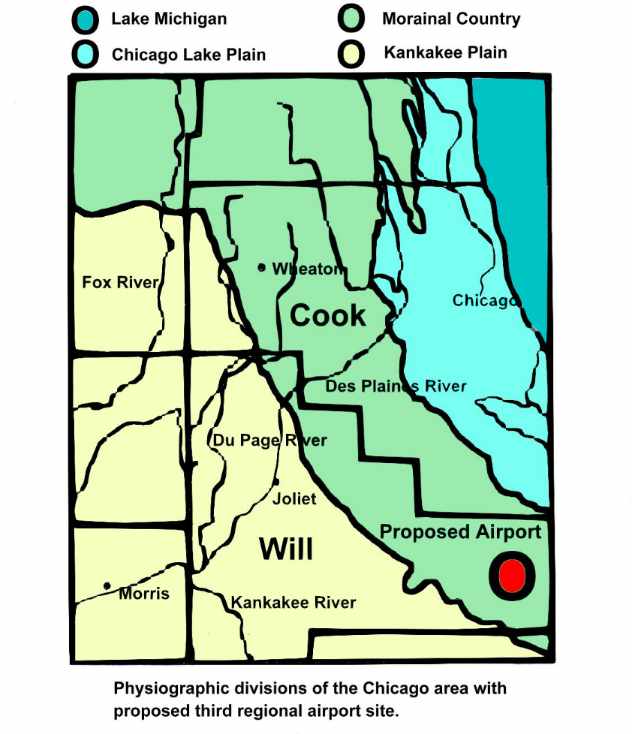 |
||
| Archaeological Sites in Peotone, Illinois And Surrounding Areas | ||
| By Margo Hupe | ||
|
The numerous archaeological sites in and surrounding Peotone, Illinois have thus far revealed, in surface hunted collections, a great number of artifacts representing Paleo through Historic Periods. The general understanding of Northern Illinois prehistory is not nearly as complete as in the rest of the state and the gap in knowledge can be attributed to two main factors. First, the destruction of the archaeological record by agriculture and urban development has been extensive in Northern Illinois and, secondly, large scale archaeological research has not been undertaken in this area. Come join us in our quest to discern the ancient past and peoples of this area while we preserve the information gathered for future generations. Governor George Ryan of Illinois, and Congressman Jesse Jackson Jr.
, also of Illinois, would like to build a third regional airport for this
area and situate it between the towns of Peotone, Beecher, Crete and Monee,
Illinois, an area that is now mostly rural farmland. The projected
size of the proposed airport encompassed 23,000 acres of land,
and while it’s original size has now been scaled down to 4,000 acres, there
remains the fact that the original 23,000 acres is still planned to be
purchased in the future and remains on the latest map provided by the Illinois
Department of Transportation. While the FAA had removed the Peotone
site as a possible Third Regional Airport our politicians are now
requesting that this area be reconsidered, even though there is much opposition
to this endeavor from 21 major airlines, Mayor Richard Daley of Chicago,
Mayor Scott King of Gary, Indiana, the general public, and many more
organizations and individuals. The FAA is now contemplating whether
this site should again be considered for a possible airport and their decision
should be forthcoming in the Fall of 2001.
In the spring of 1995, the Illinois Transportation Archaeological
Research Program (ITARP) began Phase I cultural resource survey for the
South Suburban Airport proposed by the Illinois Department of Transportation
(IDOT) and it is through this preliminary study, the first inland study
in Illinois, that we learn of the extensive habitation sites amidst the
rolling hills of this area. The study area is situated on two morraines,
the Valparaiso and the Wilton Center. Government Land Office surveys
conducted in the mid 1830’s provide little information as to the types
of flora and fauna the surveyor observed, restricting notes only to landscape
information and identifying “good soil fit for cultivation”. The
environment at the time of the survey was nearly entirely prairie dotted
by swamps, marshlands and the occasional slough. The only flowing
streams were Black Walnut Creek and Rock Creek . The largest of the
swamps is located near the eastern edge of the project area and is an abandoned
glacial meltwater channel and is to some extent still a mire today.
Survey in this swamp area revealed that it was intensively exploited from
Paleo through Middle Woodland periods. The study area supported a
diverse array of subsistence resources
Chicago lies approximately 45 miles north of the proposed airport site and prehistory covering Chicago and suburbs is incomplete and fragmented due to rapid expansion of city and suburbs and is covered in the book “Chicago Before History” by Charles W. Markman. The research reported in this book was commissioned by the Illinois Historic Preservation Agency precisely because of a concern with the rapid obliteration of sites as the suburbs have continued to grow. In Paleo times the south shore of Lake Michigan was out as far as the towns of Homewood and Glenwood, approximately 15 miles north of Peotone. Chicago reports no direct evidence of Paleo occupation, only an occasional isolated find. In Cook County documentation of sites from the Early Archaic period is sparse due to little systematic collection of evidence and relies heavily on only fifteen sites, therefore making it difficult to define any living/subsistence patterns from existing data. The Mississippian period has been investigated more than any other period in Cook County due to the relative abundance of data from this final episode of prehistory. Comparable data for earlier periods are not available locally and is known only from ephemeral surface deposits or temporally mixed contexts. The reconstruction of pre-Mississipian history depends largely on interpreting site distributions that are heavily biased by factors of differential preservation and on extrapolating from intensive site studies in other areas of the Midwest The preliminary survey conducted by Wendy Harris for the Third Regional Airport has added to the knowledge of northern Illinois cultural history and further studies are recommended. Archaeological survey of the entire project area has not been completed as of this time due to landowner refusals or the inability to locate certain landowners. Of the area surveyed it is recommended that 37 prehistoric archaeological sites may be eligible for the National Register based on the intrinsic value the sites may yield regarding local and regional cultural history. Seven historical archaeological sites are also eligible. Within the proposed airport site also lies a cemetery for the First Presbyterian Church of Will County, one of the first Euro-American cemeteries in this area. Another ten prehistoric sites located around a glacial meander scar are also recommended for further work based on the unique environment. This area has been heavily habitated from Paleo through Historic times and the archaeological record should not be lost, as has been the case in so many other areas in the past. The archaeological record belongs to us all, including the descendants of the aboriginal peoples who once roamed this region, and if it is allowed to be destroyed it is knowledge that is lost to all of us and future generations. Once sites are destroyed, for whatever reasons, they are gone forever and it is not possible to retrieve the knowledge that was contained within them. Illinois’ prehistoric sites do not deserve to be ignored and/or bulldozed under, and the stories told by them will likely greatly enhance the knowledge of this region. Along with the preliminary studies completed to date by ITARP, more documentation of collections is being done locally and more archaeologically sites should be registered in the future, for there are many sites in this area that have not been registered at this time. Join us as this story unfolds and look at the artifacts that have been retrieved, some that have been buried for over 12,000 years that now speak to us over the ages......and they tell a tale if we but listen. |
||
|
|
